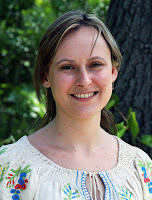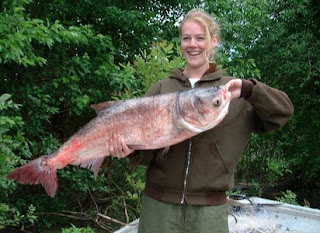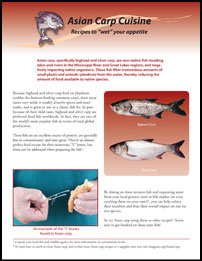January 6th, 2011 by Irene Miles
From the Milwaukee-Journal Sentinel:
The cutting-edge “environmental” DNA sampling method that sparked a multistate lawsuit to force lock closures on the Chicago canal system has for the past year been dismissed by lock closure opponents as a junk tool. A big reason: The science behind it had never been peer-reviewed and published in a scientific journal.
That argument no longer holds water.
On Wednesday, the pioneers behind isolating DNA from water samples to confirm the presence of Asian carp in the Chicago canal system published their article in the peer-reviewed journal Conservation Letters. It asserts the survey tool is not only valid, but also that the risk of an Asian carp invasion of Lake Michigan is imminent. Read more.
December 16th, 2010 by Irene Miles
From the Environmental News Network:
Global dimming is a less well-known but real phenomenon resulting from atmospheric pollution. The burning of fossil fuels by industry and internal combustion engines, in addition to releasing the carbon dioxide that collects and traps the sun’s heat within our atmosphere, causes the emission of so-called particulate pollution—composed primarily of sulphur dioxide, soot and ash. When these particulates enter the atmosphere they absorb solar energy and reflect sunlight otherwise bound for the Earth’s surface back into space. Read more.
November 16th, 2010 by Irene Miles
From the New York Times:
Scientists long believed that the collapse of the gigantic ice sheets in Greenland and Antarctica would take thousands of years, with sea level possibly rising as little as seven inches in this century, about the same amount as in the 20th century.
But researchers have recently been startled to see big changes unfold in both Greenland and Antarctica.
As a result of recent calculations that take the changes into account, many scientists now say that sea level is likely to rise perhaps three feet by 2100 — an increase that, should it come to pass, would pose a threat to coastal regions the world over. Read more.
November 11th, 2010 by Irene Miles
Margaret Schneemann (left), water resource economist with IISG and the Chicago Metropolitan Agency for Planning (CMAP), and Bud Mason (center), technical assistance provider for the Rural Community Assistance Program, have partnered together to help address financial management and rate setting issues faced by local utilities. This partnership came about through the northeastern Illinois water supply plan, WATER2050, developed by CMAP and the Regional Water Supply Planning Group, and the continuing partnership between IISG and CMAP.
Earlier this month, CMAP launched the region’s new comprehensive plan, GOTO2040. GOTO2040 emphasizes that our communities can be more livable if, among other things, we combine land use and water supply planning, and if we implement water conservation and efficiency strategies described in WATER2050. Meanwhile, the population in the region is predicted to increase by 25 percent by 2040. CMAP’s Tim Loftus, who directed WATER2050, explains, “Therein lies the central issue … How does the region accommodate millions more people with water supplies that are constrained? To avoid future shortages, water providers need to work together and consumers need to increase conservation.”
These are issues with which McHenry County Water Resources Manager Cassandra McKinney (right) is very familiar. McKinney worked over the past three years to develop the McHenry County Groundwater Resources Action Plan (WRAP) and is now bringing a series of speakers to the county to address the plan’s key implementation areas, including water conservation and rate setting.
On October 14, Schneemann and Mason spoke to the McHenry Groundwater Task Force on Water Conservation and Rate Setting on their technical assistance efforts in the region and how these could help the county implement WRAP. “Key to our efforts” McKinney said, is “proactively reaching out to stakeholders to ensure that our water supply planning efforts are coordinated with state and regional planning efforts through events such as this.”
November 4th, 2010 by Irene Miles
IISG’s new research coordinator is Tomas Höök, an assistant professor in the Department of Forestry and Natural Resources at Purdue University. Höök received his BS, MS and PhD from the University of Michigan and prior to coming to Purdue he worked at the Cooperative Institute for Limnology and Ecosystems Research and as a visiting scientist at Stockholm University, Sweden. His area of expertise is fisheries and aquatic sciences with a focus on fish and fisheries ecology in the Laurentian Great Lakes.
November 1st, 2010 by Irene Miles
The threat of Asian carp invading the Great Lakes may not be as dire as some fear. According an Illinois-Indiana Sea Grant study, the lakes’ open waters do not provide sufficient food for the fish to grow.
Asian carp species—for example, bighead and silver carp—are filter feeders. They eat microscopic plankton that provides the base of the food chain. Since these fish grow quite large, they potentially pose a threat to the Great Lakes ecosystem if they thrive in these waters.
With funding from NOAA-National Sea Grant College Program, Sandra Cooke and Water Hill, Illinois Natural History Survey ecologists, sought to answer the question of whether Asian carp can survive and thrive in the nutrient-poor Great Lakes. They estimated the energy required for the carp to survive and grow, taking into account varying body sizes, swimming speeds and reproductive stages. These numbers were analyzed in light of available food sources in the Great Lakes.
According to their modeling results, there may be sufficient plankton in some harbors and other near shore areas, but not in open waters. “Flourishing populations of filter-feeding Asian carp are historically associated with conditions that feature abundant phytoplankton and zooplankton,” said Hill. “Most areas of the Great Lakes feature relatively low abundances of these plankton.”
Ironically, the carp may just be late to the Great Lakes plankton buffet because other invasive species have already depleted the supply. “Prior invasions of the Great Lakes by zebra and quagga mussels have reduced the potential for the carp to establish populations because these mussels have reduced plankton biomass,” said Hill. “They are filter feeders too.”
But don’t write the carp off in the Great Lakes altogether. Cooke and Hill speculates that bighead and silver carp may still have significant impact on fish communities in areas where there is sufficient plankton—in harbors and nearshore areas, as well as other productive locations such as Green Bay and western Lake Erie. “Many nearshore habitats can serve as important nurseries for larval fish, including walleye and alewives,” said Cooke.
The situation is also subject to change. For example, climate change may lead to conditions in which plankton are more abundant. An increase in nutrient levels can have the same effect. As plankton numbers increase, so does the likelihood that the carp will grow and thrive.
Hill does not see these results as a reason to relent on efforts to keep Asian carp out of the Great Lakes. “Given the potential consequences to Great Lakes ecosystems if these filter feeders do prove capable of establishing reproducing populations, efforts to keep Asian carp out the Great Lakes must not be lessened,” he said. Rather, this work can provide insight for resource managers to direct their monitoring and prevention efforts to areas that are most at risk.
Results from this research are published in the October 2010 issue of Freshwater Biology (55).
October 27th, 2010 by Irene Miles
Priscilla Viana is a Knauss Sea Grant fellow in the Division of Ocean Sciences (OCE) at the National Science Foundation. She is involved in several programs related to aquatic sciences, and their interactions with earth and atmosphere.
Here is her latest report:
During the first months of my fellowship, I worked in the Ecology of Infectious Disease (EID) and in the Ocean Acidification (OA) Programs. These activities enhanced my ability to write grant proposals. I have learned how to address the NSF intellectual merit and broader impact criteria, how panelists and program officers evaluate a proposal and the main components of an awarded proposal.
The EID program is supported by the Biological Sciences and the Geosciences/OCE Directorates of the NSF and by the NIH. I helped in the proposal review process and attended a workshop at Atlantic City, NJ, where principal investigators presented ongoing and past EID project results. This year we reviewed about 70 proposals and 10 grants were awarded with a total investment of about $12 million.
After my first contact with the NSF proposal review process, I worked in the OA Program, which is a new competition supported and managed by the Office of Polar Programs, Directorate for Geosciences, and Directorate for Biological Sciences of the NSF. It was very useful to gain knowledge of all steps related to the implementation of a new program. I participated in the expert panel, responsible for reviewing about 120 proposals, and in the funding decision process. 22 grants were awarded with a total investment of about $24 million.
After the OA program, I became involved in the Interagency Working Group on Ocean Acidification (IWG-OA). The IWG-OA is composed by members of the NSF, as well as from NOAA, U.S. EPA, U.S. FWS, U.S. Navy, Department of State, NASA, USGS and BOEMRE. We are preparing the strategic research plan on OA requested by the Federal Ocean Acidification Research and Monitoring Act of 2009 (FOARAM Act). This report will be submitted to the Committee on Commerce, Science, and Transportation of the Senate, and to the Committee on Science and Technology and the Committee on Natural Resources of the House of Representatives. Its objectives are to understand the current research status, identify gaps that need to be filled and establish near and long term OA monitoring, research and modeling priorities. This strategic plan will also identify technology development and data management needs, assess the socioeconomic impacts of OA and recommend strategies to conserve marine organisms and ecosystems. It has been a very rewarding experience to learn about the role of different agencies and organizations in planning policy initiatives, while also being in contact with academic and agency scientists.
I also worked with my supervisor Phil Taylor (Head of the NSF Ocean Section), NOAA, USGS, BOEMRE and NIH to coordinate the Deepwater Horizon (DWH) Oil Spill Principal Investigator’s Conference held in St. Petersburg on October 5-6, 2010. The meeting was sponsored by the National Science and Technology Council’s Joint Sub-Committee on Ocean Science and Technology (NSTC JSOST). The conference was a joint effort of multidisciplinary parties. Researchers were invited to summarize recent advances from the current studies associated with the DWH spill, to identify research challenges, and to foster collaboration. Agencies actively conducting DWH oil spill related research, monitoring, and sampling, as well as representatives from the NSTC JSOST agencies, focused on identifying in conjunction with researchers short and long term research directions, and on developing recommendations to improve future oil spill response action. More information about this meeting can be found at: http://www.marine.usf.edu/conferences/fio/NSTC-JSOST-PI/
I am starting the ninth month of my fellowship. I have now a better idea of how policy is made and the importance of having scientists contributing to the policy making process. The effective management of marine resources can only be achieved when scientists are included in policy debates and are able to inform policy makers about the importance of their findings. I have gained a broad experience helping to coordinate scientific meetings and helping to set research priorities on ocean acidification and on the DWH oil spill crisis.
Being a Knauss fellow involved in all these different activities has been an exciting and intensive learning experience. This fellowship is certainly enhancing my skill set to address issues of public policy and academic fields.
October 21st, 2010 by Irene Miles
The best way to fight the invasion of Asian carp may be to visit the fish counter at your local supermarket, if recommendations from the Asian Carp Marketing Summit come to pass. One conclusion from this gathering of experts is that filleting bighead and silver carp may prove a key tactic in the war against these fish.
Bighead and silver carp are thriving in the Mississippi and Illinois rivers, and as DNA traces and individual fish are found in or near Lake Michigan, concerns are high regarding the potentially devastating impact of these fish on the Great Lakes. The search is on for solutions.
“The summit was convened to identify obstacles and opportunities associated with commercial marketing of Asian carp as a way to reduce their numbers in the Mississippi River Basin, “ said Pat Charlebois, Illinois-Indiana Sea Grant (IISG) aquatic invasives specialist. This two-day event took place at the Lewis and Clark Community College in Godfrey, Illinois. It was organized by IISG, with sponsorship from the Illinois Department of Natural Resources (IDNR) and the National Great Rivers Research and Education Center.
Gathered together in one room were representatives from restaurants, commercial fishing, processing and related businesses, plus agencies, and academic institutions. Altogether, experts from eight states shared their insights and ideas.
“The tricky aspect about creating a marketing plan for an invasive species such as Asian carp is that we ideally want to eradicate them or at least greatly reduce their populations, so a sustainable fisheries is not the end goal,” said Kristin TePas, IISG aquatic invasives extension associate. “Because large-scale marketing has not been used like this before, we have to be careful how we proceed. There is not precedence for what we’re trying to achieve.”
The experts agreed that high value Asian carp fillets marketed to restaurants and retailers may provide the financial incentive for extensive harvesting of these fish. Looking to have immediate impact, they also recommended that whole fish be exported in high numbers to Asian markets, where these species are popular food fish. Because they are filter feeders, bighead and silver carp are regarded as tasty fish and are generally low in contaminants.
Finally, they recommended converting Asian carp by-products into pet food or treats to eliminate waste and maximize profit opportunities.
“Over the course of the two days, the participants came to a consensus on next steps needed to go forward,” said Charlebois. “They concluded that it’s necessary for people with different expertise, for example, natural resource professionals and entrepreneurs, to work together to successfully market Asian carp.
“Nonetheless, this process will ultimately be driven by those who make their livelihood from the market itself,” added Charlebois. “Natural resource agencies can play a role by reducing commercial fishing restrictions and protecting natural resources. Government agencies focused on business can help a company obtain funding. But, ultimately the success of this is in the hands of business people.”
When the final summit report is completed, a summary of recommendations will be available online and updated as information progresses.
October 14th, 2010 by Irene Miles
In many parts of the world, Asian carp are known as dinner–these fish have a mild flavor that belies their unfortunate name. So perhaps we can try and eat our way out of the ecological threat they pose. IISG has created a publication–Asian Carp Cuisine–that provides a variety of recipes for preparing bighead and silver carp, including Jamaican Jerk Carp, and Silverfin Cakes, as well as smoked and fried Asian carp.





